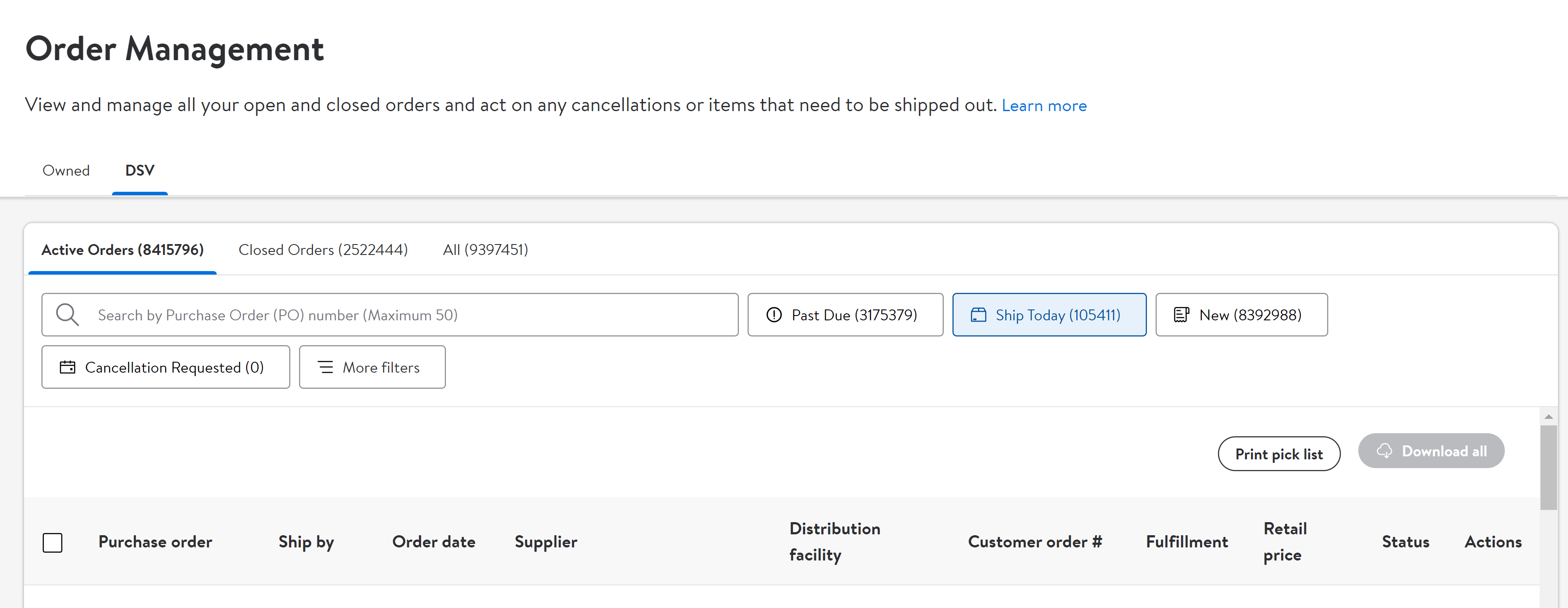Operational Expectations - On-Time Delivery
Delivering to customers on time is one of the most important responsibilities of Walmart and its partners. Not only does on time delivery positively impact the customer experience, it also reflects positively on your On-Time Delivery (OTD) metrics and can save money by avoiding Performance Management chargebacks. This article will explore what OTD is, how you can ensure you are impacting OTD, and how Walmart measures OTD.
On-Time Delivery
OTD is a measure of performance and efficiency that quantifies the number of units delivered to customers relative to the date Walmart promised during checkout. On-time shipping is a component of OTD. Every PO is assigned an expected ship date (ESD) and timestamp. You must ship each PO on or before the ESD date and time to be considered on time.
Each warehouse is assigned a daily order cut-off time of 12:00 PM based on the time zone of the shipping location. (12:00 PM is the default cut-off time. You can set a different cut-off time by adjusting your warehouse settings. Learn more here.)
Orders received before the daily cut-off time may have an expected ship date of the same day. You can see the expected ship date in the Order Management Dashboard in Supplier One when you click Active Orders. For orders transmitted via EDI or API, the ESD is transmitted with each PO in the purchase order file.

Measuring On-Time Delivery
To ensure orders are shipped by the ESD, Walmart verifies the Supplier One ship confirmation or ASN timestamp. You must provide Walmart with shipping confirmation and valid tracking information. Once we receive shipping confirmation, we will notify the customer that their order is on the way. Shipping confirmation must be received on or before the ESD but no earlier than 24 hours before the ESD. These ASN timestamps must also reflect as closely as possible to when the carrier picked up. DSVs are expected to maintain and manage a relationship with their local carriers to ensure that they pick up packages daily and on time. Please note that your ESD timestamp will always match your Distribution Warehouse's carrier cut-off time.
OTD Calculation: Units delivered on or on day before the Original Expected Delivery Date (OEDD) that is promised to the customer during checkout.
Walmart DSV Expectations
- Late Deliveries should not exceed 5% of units
- Early Deliveries should not exceed 10% of units
OTD Reason Codes for Vendor and Carrier Controlled Defects
Reason | Early/On-Time/Late | Reason Owner |
EARLY SHIPMENT | EARLY | Vendor |
EARLY TRANSIT | EARLY | Carrier |
ON-TIME DELIVERY | ON-TIME DELIVERY | Vendor, Carrier, and Walmart |
FULFILLMENT LATE PROCESSING | LATE | Vendor |
CEDD > EDD | LATE | Vendor or Carrier |
MISSING DELIVERY | LATE | Vendor or Carrier |
LATE TRANSIT | LATE | Carrier |
Early Definitions
- Early Shipment - Early shipment defects populate when an order is shipped more than 24 hours before the Expected Ship Date (ESD) and a package delivers more than 1 day early to the customer. This defect can be identified by the ASN timestamp being dated 24 hours or more before the ESD timestamp for each order.
- Early Transit - When the Delivery Date is earlier than the Original Expected Delivery Date (OEDD) and a package delivers more than 1 day early to the customer. The Carrier delivered before their own SLA even when their CEDD scan aligned with the Walmart Promise. To identify, the package delivery timestamp is before the carrier commit timestamp.
Late Definitions
- Fulfillment Late Processing - Fulfillment Late Processing populates when the operations or systems at the fulfillment center caused the package to be delivered late. This defect can be identified by the ASN timestamps being dated after the ESD timestamp for each other.
- CEDD > EDD - Stands for Carrier Expected Delivery Date and (Walmart's) Expected Delivery Date. This populates when the carrier committed to delivering the package after Walmart's EDD, and the package was delivered late. This can happen if Walmart packages are handed off too late in the day to the carrier, causing the first origin scans to be late and getting pushed out to the following day (or) a later sort.
- As a best practice, please prioritize Walmart packages to ship as early in the day as possible so that they can make a twilight sort; ideally, pickups are happening no later than 6 PM local time. Please work closely with your local FedEx rep to align on your cut times to ensure that you're set up for success.
- Missing Delivery - No delivery timestamp on the order.
- Vendor Controlled
- No Carrier Scan - Invalid Tracking Number - This occurs when there is a missing delivery and no carrier scan is received and invalid tracking number. Please review your EDI settings and the tracking numbers that are being sent on ASNs to ensure they're correct.
- No Carrier Scan - Unknown - This usually occurs when the shipping label has been created, but there is no carrier scan, so FedEx does not have possession of the package. Please DO NOT prematurely print labels. Labels should be printed as closely as possible to the carrier pick-up time.
- Carrier Controlled - Missing delivery can be carrier controlled when a carrier scan has been received, but the carrier EDD has passed the current date.
- Vendor Controlled
- Late Transit - This defect populates when the carrier is unable to meet their own commit date when it tied with the Walmart Promise. To identify, the package delivery timestamp is after the carrier commit timestamp. Oftentimes, missing deliveries with valid tracking numbers will bucket into late transit defects once those deliveries occur.